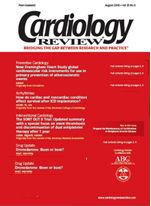Publication
Article
Cardiology Review® Online
The GEMINI trial: The role of carvedilol in treating hypertensive patients with diabetes
TThe Glycemic Effects in Diabetes Mellitus: Carvedilol-Metoprolol Comparison in Hypertensives (GEMINI) trial demonstrated that carvedilol (Coreg) provided the same antihypertensive efficacy as metoprolol (Lopressor, Toprol) in hypertensive patients with diabetes but without the adverse metabolic effects of the latter drug. The results, consistent with those of other studies, suggest that carvedilol is preferable to metoprolol in treating hypertension in this population. It is not known whether the demonstrated differences in metabolic parameters are predictive of a long-term difference in cardiovascular events. Nevertheless, in the absence of any other compelling reason to select metoprolol, it would seem logical to select a drug with fewer adverse metabolic effects in patients who are at considerable risk by virtue of having both diabetes and hypertension.
What is the mechanism of the
difference between the two agents?
Beta-blocking agents tend to reduce cardiac output and increase peripheral resistance, resulting in reduced blood flow to muscle, and hence reduced glucose uptake and increased insulin resistance. Nonselective beta blockers block both cardiac beta1 receptors and peripheral beta2 receptors, resulting in unopposed peripheral alpha-receptor—mediated vasoconstriction, further reducing muscle blood flow and glucose uptake. Carvedilol, unlike low-dose metoprolol, is a nonselective beta blocker; but it possesses an alpha-blocking effect that may be responsible for vasodilatation.
Alpha-receptor blockers, such as doxazosin (Cardura), have been shown to be less effective than other antihypertensive agents as initial monotherapy for lowering blood pressure and preventing cardiovascular events, particularly heart failure.1 They are not bad drugs, however, and if anything have favorable metabolic effects, such as increased insulin sensitivity. When added to a beta blocker, an alpha blocker provides a potent antihypertensive effect, and can ameliorate the negative hemodynamic and metabolic effects of beta blockers. It is surprising, therefore, that carvedilol’s alpha-blocking effect is not mentioned in the GEMINI report as a possible mechanism of its better metabolic profile.
Another contributor to the difference in metabolic effects between the two study drugs, and a potential weakness of the study, may have been the dose employed. The maximal dose of carvedilol, 25 mg twice daily, is widely used. The maximal dose of metoprolol (200 mg twice daily), on the other hand, is much higher than that which is widely used. Further, in GEMINI, increasing the metoprolol dosage from 200 to 400 mg per day had little additional antihypertensive effect while likely contributing to greater adverse metabolic effects. The greater reduction of heart rate and the higher incidence of bradycardia, fatigue, and weight gain in the metoprolol group are consistent with the likelihood of a greater degree of beta blockade in metoprolol-treated subjects, which might partially explain differences between the two drugs in metabolic outcome. Interestingly, in the Carvedilol Or Metoprolol European Trial, which compared efficacy of these two drugs, the maximal dosage of metoprolol was only 50 mg twice daily, which achieved a fall in heart rate equal to that seen with carvedilol.2
Practical implications of
GEMINI in terms of treating hypertensive diabetic patients?
The most important factor in treating hypertension in patients with diabetes remains adequacy of blood pressure control. The GEMINI protocol differed from recommended approaches by combining an angiotensin-converting enzyme (ACE) inhibitor or an angiotensin receptor blocker (ARB) with a beta blocker. This combination has a lesser antihypertensive effect than regimens that combine an ACE inhibitor or ARB, which targets the renin-angiotensin system, with either a diuretic, which targets the volume component of hypertension, or a calcium channel blocker.
Beta blockers are clearly effective in secondary prevention of coronary events and in treating heart failure. Their early use to treat hypertension cannot be advocated, however, particularly given growing evidence that other antihypertensive agents are more effective than beta blockers in primary prevention.3,4
Finally, if combined alpha/beta blockade is desired, other drugs provide more reliable alpha/beta blockade than does carvedilol. Carvedilol, a lipophilic beta blocker, is subject to extensive first-pass hepatic metabolism, resulting in inadequate blood levels in many who take the drug. In fact, the bioavailability of the s-enantiomer responsible for most of carvedilol’s beta-blocking effect is only 16%.5 The combination of a nonlipophilic beta blocker along with an alpha blocker, such as doxazosin, has more consistent bioavailability. Unfortunately the long-term outcome of combined alpha/beta blockade using agents other than carvedilol has not been studied.
In summary, carvedilol was associated with fewer adverse metabolic effects than high-dose metoprolol, and would thus appear preferable in patients with insulin resistance, such as diabetic patients. In treating the diabetic hypertensive patient, beta blockers should not be considered preferable to other drug classes as first or second-step therapy, in the absence of other specific indications for their use.
